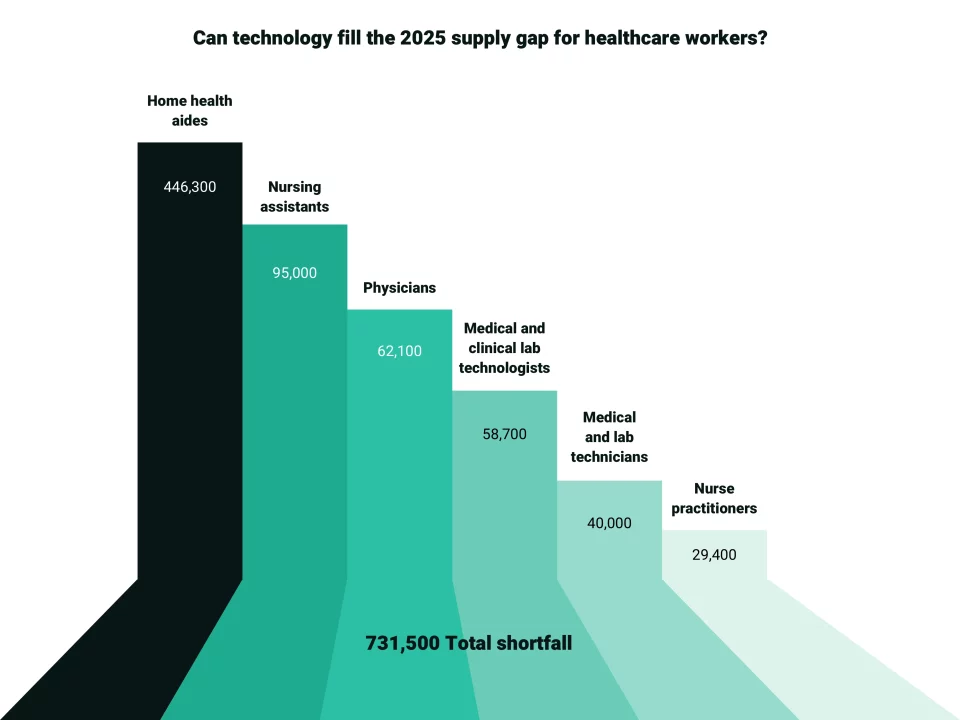INTRODUCTION
Clinician burnout to catalyze digital transformation in the US healthcare sector
Through 2023, healthcare providers in the US have expressed interest and inclination to invest more in technology solutions to fight challenges.
The healthcare sector faces a slew of challenges: clinician burnout, a spike in patient-care demands from an aging population, the end of public health emergency waivers and flexibilities post-COVID-19, and skill shortages. Plus, a rapidly shrinking workforce, which is the result of:
- Rise in mortality of working-age Americans due to lifestyle diseases like diabetes and obesity, alcoholism, drug abuse, and suicide. The trend has been exacerbated post-COVID-19.
- Baby boomers (born 1946-64) are retiring, but fewer young Americans are replacing the workforce, as fertility rates have plummeted since 2007.
- Not enough professionals pursue a career in healthcare.
- Medical professionals face burnout and leave jobs.
- Policies that govern the labor force, employee welfare, and hiring practices inhibit full labor participation.
- Immigration policies in recent years have created a systemic backlog that hasled to shortages of workers.
The potential of technology to transform workflows and processes and enhance productivity seems to have struck the right chord among providers.
Timely technology intervention needed
In a survey conducted in June 2023 of 201 respondents–executives of healthcare provider organizations–80% were spurred by medical labor shortages and cost pressures to accelerate their spending on:
- Information technology
- Software
- Emerging technologies
- Revenue cycle management
- Clinical workflow optimization
- Patient engagement
- Healthcare cybersecurity plan
- Electronic Health Records (EHRs)
Six percent of the respondents already had a generative AI strategy, while 50% were actively developing one. Hospital digital transformation is paving the way for solutions that optimize provider productivity and asset utilization while improving patient satisfaction.
STATISTICS
What is a secular labor shortage, and how can it cripple the healthcare industry?
A secular or long-term labor shortage is one that is indefinite. In other words, there is no end in sight. Let us take a close look at some numbers to understand the gravity of the situation.
- The American Hospital Association estimates the industry will face a shortage of up to 124,000 physicians by 2033. This includes shortages of primary care physicians and specialists, such as pathologists, neurologists, radiologists and psychiatrists.
- The Bureau of Labor Statistics projects 193,100 openings for registered nurses each year, on average, in the decade spanning 2022-2032. Much of the demand will be generated as workers transfer to different occupations and exit the labor force, including retirement.
- Industry market analytics firm Mercer estimates that the US will have a shortage of about 446,000 home health aides by 2025, with rapid turnover a particular problem.

Healthcare organizations should prepare for the medical labor shortages with technology solutions Source: OliverWyman.com
Bureaucratic tasks
- Between 35% and 54% of U.S. nurses and physicians have symptoms of burnout, characterized by the National Academy of Medicine as high emotional exhaustion, high depersonalization or cynicism, and a low sense of personal accomplishment from work.
According to the Medscape Physician Burnout and Depression Report 2023: “I Cry but No One Cares,” 61% of the respondents said too many bureaucratic tasks contributed most to their burnout. 25% complained that it was EHRs or computerization of practice that caused depression.
A JAMA Internal Medicine Report has found that US physicians spend 1.84 hours completing documentation daily outside of office hours. This adds up to 9.2 hours a week. Assuming a five-day work week and 47-week work year, the researchers estimated US physicians spent 125 million hours documenting outside office hours in 2019.
Meanwhile, a joint survey by the American Nurse Association and McKinsey in May 2023, has revealed that insufficient staffing, high patient loads, poor and difficult leadership and excessive time spent on administrative tasks were the main causes of burnout.
- 56% of the respondents experienced symptoms of burnout such as emotional exhaustion.
- 64% said they felt a great deal of stress because of their jobs.
- More than a third of the nursing respondents felt they spent excessive time working on electronic health records on breaks or after shifts, and 45% reported this activity adds frustration to their day.
Negative impact on providers
Clinician burnout and high attrition levels both affect organizational productivity and efficiency. When operations are hampered, patient experience is poor, and the hospital loses business. Financial stress has an adverse impact on the quality of treatment, and the sick who come for treatment may even die due to want of specialized care, lack of sophisticated medical equipment, absence of well-coordinated treatment pathways, and neglect by overworked staff.
Burnt-out nurses may make costly mistakes, and doctors burdened by documentation work may get frustrated and lose focus. When clinicians quit and the healthcare providers are back to hiring, they may find a dearth of qualified professionals - due to the medical labor shortages we discussed earlier in this post. The cycle of woes thus continues, and healthcare in the country can be crippled.
Explore the transformative potential of digital technologies in addressing medical labor shortages.
RECOMMENDATIONS
Healthcare providers must integrate new technologies that promote agility
We have seen how hospitals and healthcare systems across the US have gradually started investing in technology to promote value-based care, support population health management and clinical integration. It is also possible to leverage digital transformation through customized healthcare software development to enhance productivity and efficiency.
The American Hospital Association has recommended that healthcare providers use technology in the following ways to enhance the work experience of professionals.
- Use digital means to offer easy access and greater speed. Support individuals and teams through digital wellness solutions. Provide leadership training and guidance for managers on building and engaging diverse teams.
- Reduce burden using tools that help with administration, revenue cycle, or other routine tasks. This can include intelligent IoT automation through robots and artificial intelligence.
- Enhance flexibility with agile scheduling solutions, predicting demand, or creating enterprise staffing solutions or labor pools.
- Reduce friction by digitizing human resources functions, streamlining routine interactions, and smoothing processes like credentialing.
- Optimize care delivery using artificial intelligence, predictive analytics, and virtual health options that allow more flexibility. Introduce remote staffing, greater team-based coordination, and clinical just-in-time training. Make mental health EHR software more user-friendly.
SOLUTIONS
Pick solutions that suit your requirements and customize them for best results
There are any number of technological interventions that the US healthcare industry, especially the workforce can benefit from. Here is a list of potential applications to remedy the situation arising out of medical labor shortages.
- Remote patient monitoring (RPM): Clinicians who are involved in chronic disease management especially stand to gain from remote patient monitoring toolkit, as it facilitates frequent communication and data sharing between visits. Chronic diabetics, congestive heart failure and hypertension patients benefit from adjustments to medications based on data.
- Robotic process automation (RPA): RPA takes over all repetitive chores. Physician burnout from data entry, extraction and report writing can be reduced by automating EHR processes. Automated patient care communications, including lab tests, appointment reminders, feedback, and personalized medicine messages, reduce the workload and improve patient treatment.
- Virtual nursing assistants: Nurse workloads can be reduced with the use of apps and chatbots, with a friendly name and avatar added for a human-like experience. Chatbots can assess symptoms, monitor vital signs, update EHRs, and conduct senior citizen engagement activities, including reminders on medication and exercise regimens.
- AI-enabled diagnostics: Causal reasoning in machine learning techniques has generated algorithms that can be used to reduce the cognitive workload on doctors and enable a quicker and more accurate diagnosis. AI helps to identify new biomarkers, early disease indicators, and the responsiveness of a patient to a drug.
- AI-assisted documentation: Ambient clinical intelligence allows clinicians and patients to interact, while NLP transcribes it, with standardized medical nomenclature and formats it into a clinical note, to be integrated into the EHR after review by the doctor. AI handling of administrative chores like admissions, insurance and billing relieve clinicians’ burden.
- AI-supported medical scans: With AI-support, radiologists are able to reduce their reading time of tomosynthesis images that detect breast cancer. ML tools are out-performing clinical practice in identifying lung and pancreatic cancer; AI can assess fracture, detect brain changes that cause stroke and Alzheimer’s disease, and analyze heart’s electrical activity.
- Modernization of EHRs: Healthcare providers are launching their own customizations to reduce voluminous data entry work in bulky EHRs documentation. The redesign done with the help of experienced nurses, involves deletion of a number of flowsheets and values, standardization of workflow processes and record keeping, focused on usability and efficiency.
Discover how innovative digital solutions can solve healthcare staffing challenges with our custom software solutions.
CONCLUSION
Physicians and nurses need tender loving care too
In addition to the above, many interventions can be introduced to improve the well-being of healthcare professionals, too.
Digital wellness tools that promote mental peace in a demanding work environment help physicians overcome stress and “moral injury” with meditation, deep breathing, and relaxation techniques. Confidential screening tools and AI-apps are now being used to detect depression and suicidal tendencies, through journalling, questionnaires and keyword alerts.
Hospitals are customizing alarm management systems to prioritize and filter clinical alerts from the myriad of medical devices in order to reduce unnecessary disruptions and cognitive overload.
mHealth initiatives empower clinicians with digital patient engagement tools that offer flexible work styles and reduce work-related stress. Fitness apps encourage healthy lifestyle choices, physical activity, personalized workout routines. Sleep tracking devices monitor sleep patterns and offer insights to improve sleep quality, to get better rest and recharge sufficiently to meet the demands of the professions.
Psychological protective personal equipment -a set of guidelines popular during the pandemic, are being adapted for continued use to ensure work-life balance among clinicians.






